| cgWindWaves
Forecasting of wind generated waves |
| The wave forecasting
methods are both empirical and theoretical. Many factors are involved in wave forecasting,
especially in restricted fetch areas. The wave forecasting methods are based on
semi-empirical relations (SMB methods, Sverdrup, Munk, and Bretschneider), which link the
significant wave height Hs and significant wave period Ts to wind speed U, fetch length F,
and water depth. The wave forecasting procedures is largely graphical, and laborious. The program cgWindWaves gives an estimate of the
waves in restricted fetch water regions. From the water region defined by its map, the
mean wind direction and wind velocity, you obtain the significant wave height Hs, and wave
period Ts, and a wave spectrum S(f). The wave prediction is based on the combination of
various theories for wave forecasting, for directional effects, and wave spectra, which
are implemented in the program. Application of the program is for regions where refraction
is negligible.
The program implements the directional wave effects using
either Seymour's, Savil's or effective fetch method. The significant wave and period
forecasting from the wind velocity and fetch is based on Bretschneider's or Wilson's
method. For the wind energy Pierson-Moskowitz and JONSWAP spectra are used. All the data
are in one main screen (water region, wind direction and velocity, selection of theories),
and the forecasted wave characteristics, spectrum and time series sample, are shown
immediately. |
|
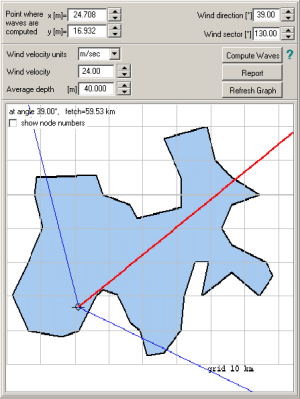 |
After
specifying the water region, which is defined by its map, the mean wind direction and wind
velocity, you can obtain the significant wave height, wave period and a wave
spectrum. The water region is defined by its
outline specifying the coordinates of its nodes. More than one outline may be defined in
order to describe regions with islands. The coordinates of the region nodes may be also
read from a text file.
You can define the water
region in three ways:
1) Graphically by clicking
at the nodes, in the graphical package which is included in the program. The graphical
pachage is simple and customized for the particular program.
2) By entering the X and Y
nodal coordinates of the outline in a table.
3) By reading the nodal
coordinates of the outlines from a text file.
Program units:
Metric (m, km, m/sec, km/h) or US Units (ft, miles,
ft/sec, m.p.h) |
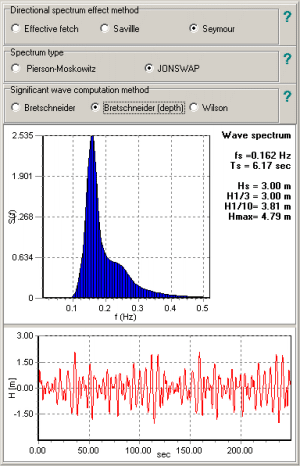 |
User options :
- The directional spectrum
effects
Effective fetch
Savil's
method
Seymour's
method
- The method of significant
wave computation
Bretschneider method
Wilson
method
- The type of wave spectrum
Pierson-Moskowitz
JONSWAP
With a click of a mouse,
you can change the wind direction or velocity. The resulting wave characteristics, wave
spectrum and a sample wave record are shown simultaneously. |
 |
 Complete Help Complete HelpA context-sensitive Help system, guides you through
the use of the program and the theoretical background.
On-line user's manual and frequently asked
questions (F.A.Q.) are included in the program. |
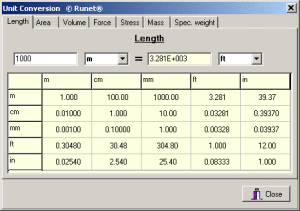 |
 Engineering
tools Engineering
toolsUnit conversion |
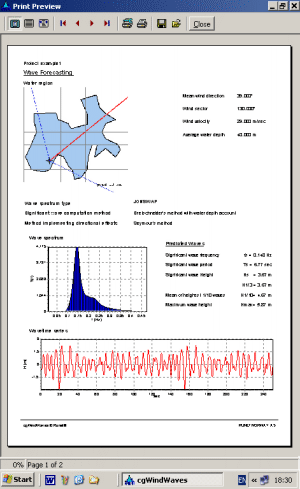 |
Reports
- Preview Reports
- Print reports
- Theoretical summary preview
- Theoretical summary print
Samples of report in pdf
format
| Please note that these files require you have the Adobe
Acrobat Reader installed. If you don't have the reader, click here
to download it. (its free) |
 |
|

|
|
| Short
theoretical background The
wave forecasting methods are both empirical and theoretical. Many factors are involved in
wave forecasting especially in restricted fetch areas where refraction is involved. The
wave forecasting methods are based on semi-empirical relations (SMB methods, Sverdrup,
Munk, and Bretschneider), which link the significant wave height and significant wave
period to wind speed, fetch length and water depth.
In a water region defined by its map, the region of the water is
divided in sectors radiating from the point where the wave characteristics are to be
determined. These sectors are symmetrically disposed about a center line which is directed
up-wind along the main wind direction. For each of these sectors the significant wave
height (Hs) and wave period (Ts) are predicted, using one of three known methods:
two methods by Bretschneider, one without taking into account the water
depth and one taking into account the water depth, and one method by Wilson.
The wave forecasting of the water region is based on a wave spectrum
which is obtained by taking into account the contribution of each of these sectors the
water region is divided. Three methods are applied in the program for this contribution,The
effective fetch method, Saville's method and Seymour's method.
For the wave spectra the two known spectra by Pierson-Moskowitz
and JONSWAP are used.
Look at Documentation
for the program for more detailed methodology. |
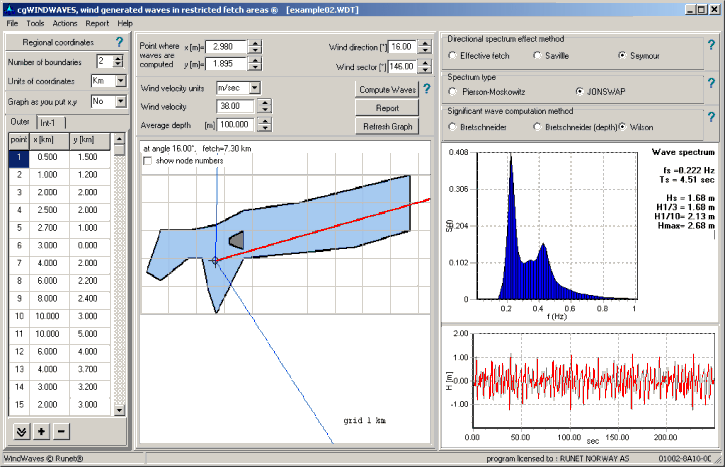 |
|
|
|
|

